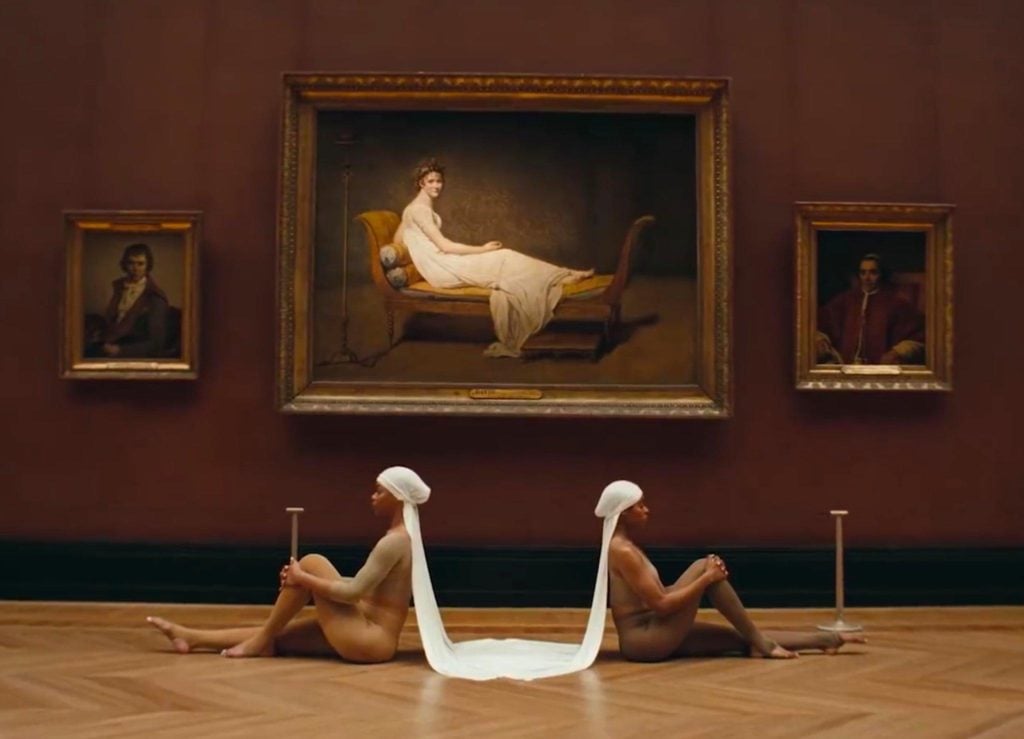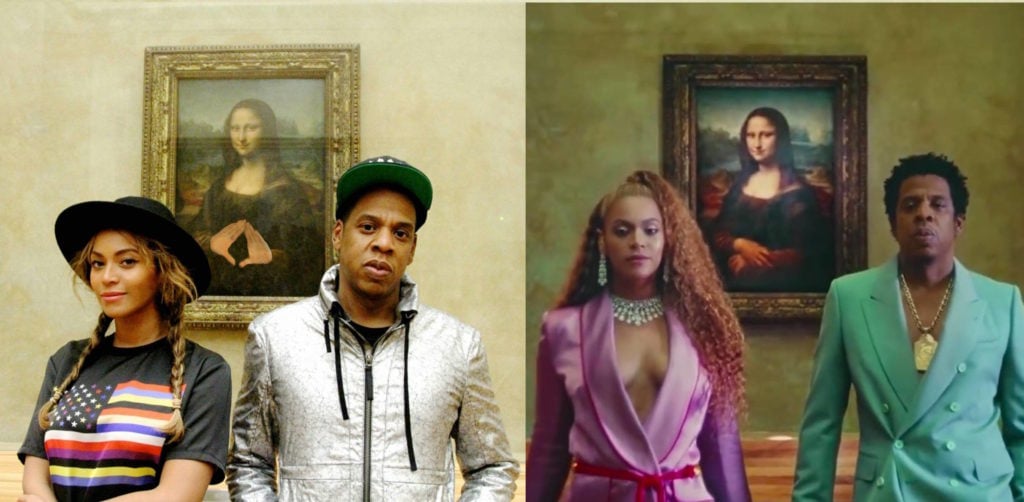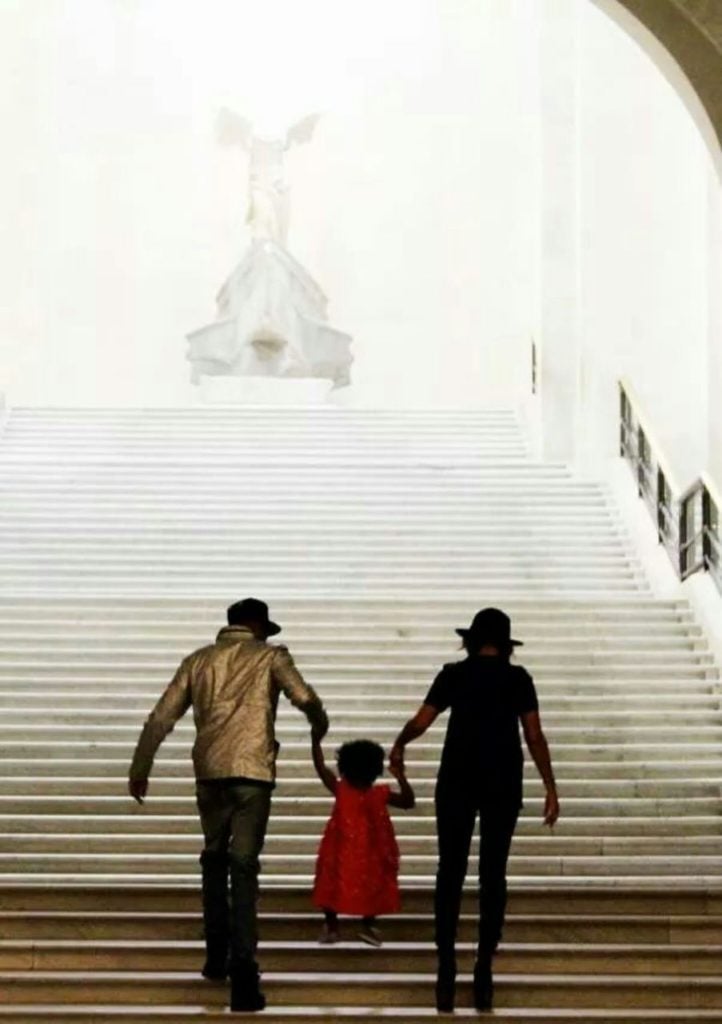People
‘I May Need to Lie Down’: The Art World Goes Nuts Over Beyoncé and Jay-Z’s Louvre Takeover on Social Media
The megastar couple took over the Louvre to shoot the music video for their new joint album's lead single.

The megastar couple took over the Louvre to shoot the music video for their new joint album's lead single.

Sarah Cascone

They did it again. Over the weekend, Beyoncé and Jay-Z (aka the Carters) sent ripples through the pop-cultural landscape. The megastar couple dropped a new joint album, Everything Is Love, heralded by the video for its lead single, “Apeshit.” Shot at the Louvre in Paris, the video not only showcases the couple’s particular brand of fine-art appreciation but also asserts their rightful place among the masterworks at the world’s most prestigious art institution.
And if reactions on social media are any indication, the art world is fully on board—starting with the Louvre.
“Beyoncé and Jay-Z visited the Louvre four times in the last 10 years,” a museum spokesperson told artnet News. “During their last visit, in May 2018, they explained their idea of filming. The deadlines were very tight but the Louvre was quickly convinced because the synopsis showed a real attachment to the museum and its beloved artworks.”
According to the museum’s Twitter account, some 500 productions film onsite each year, with fees topping out at 15,000 euros per shoot, or about $17,500, as of 2015. And while Jay-Z and Beyoncé may have made a last-minute request of the institution, they appear to have been mulling over the visuals for “Apeshit,” which was directed by Ricky Saiz, for quite some time.
In October 2014, the couple visited the Louvre with artist Awol Erizku, who famously shot their Instagram sensation of a pregnancy announcement photograph for twins Sir and Rumi. Erizku photographed the couple and their oldest child, Blue Ivy, in front of several works that appear prominently in their new video.
First and foremost, of course, is Leonardo Da Vinci’s Mona Lisa, arguably the most famous work of art in the world. The music video recreates Erizku’s photographs of the Carters posed in front of the masterpiece, clad this time in matching his-and-hers light pink and blue suits.

Beyoncé and Jay-Z on vacation at the Louvre, and in their new music video “Apeshit,” posing both times with the Mona Lisa. Photo courtesy of the artists.
“At this point, Beyonce and Jay-Z have probably spent more time with the Mona Lisa than the President of France,” joked Carolina A. Miranda, culture writer for the Los Angeles Times, on Twitter.
Other observers pointed to the symbolic significance of the pose. An art history student who goes by @tsmeheidi_h on Twitter wrote in a tweet that the singer “is visually asserting herself as Mona Lisa,” and that “essentially, #Apeshit is not only a brilliant celebration of Beyoncé and Jay-Z’s success but a self-aware acknowledgment of their success in the face of historical/current oppression as well as an expression of gratitude to their predecessors who are too often forgotten.”

A scene from Beyoncé and Jay-Z’s new music video “Apeshit,” and a photo of the couple and daughter Blue Ivy on vacation at the Louvre, posing both times with the Jacques-Louis David’s The Consecration of the Emperor Napoleon and the Coronation of Empress Joséphine. Photo courtesy of the artists.
“I think it was important to my mother to surround us with positive, powerful, strong images of African and African-American art so that we could see ourselves in them,” Beyoncé told the New York Times in 2017. Now, the singer is not only creating those images for herself, she is reimagining masterpieces of art history with people of color standing in for the Mona Lisa and other traditionally white figures.
This theme is perhaps most pronounced when Beyoncé and a troupe of dancers stand boldly facing the camera in front of Jacques-Louis David’s The Consecration of the Emperor Napoleon and the Coronation of Empress Joséphine. It’s the inverse of a Carter family photo from their last Louvre visit, where they are staring up at the European royals. Now, Josephine’s crown appears to rest on Beyoncé’s head.

Beyoncé, Jay-Z, and daughter Blue Ivy on vacation at the Louvre with the Winged Victory of Samothrace. Photo courtesy of the artists.
Back in 2014, the Carters also posed with one the Louvre’s most famous sculptures, at the foot of the staircase beneath the Winged Victory of Samothrace, now featured prominently in “Apeshit.”
Other shots include the golden Apollo Gallery, the majestic skylights of the Grande Galerie, the Great Sphinx of Tanis in the museum’s Egyptian galleries, and IM Pei’s glass pyramids, as well as notable works such as the Venus de Milo, Théodore Géricault’s The Raft of the Medusa, and David’s Portrait of Madame Récamier, Oath of the Horatii, and The Intervention of the Sabine Women. The video also highlights historical works of art featuring black figures, like Marie-Guillemine Benoist’s Portrait of a Negress.
Without a doubt, Beyoncé and Jay-Z are inserting themselves into the Western art canon and advocating for the importance and inclusion of persons of color in the hallowed halls of Western civilization.
“What does it mean to host a black cultural moment in a traditionally white space?” asked Kimberly Drew, the Metropolitan Museum of Art’s social media manager, on Twitter. “Yes, it affirms that we belong in these spaces, but we have to remain curious about this choice. These performances could have been hosted at studio museum, project row houses, art&practice, caam, etc. but these white spaces are the ones that we see.”
1. Beyonce music videos https://t.co/MpJTupQNpY
— Jeanette Hayes (@jeanettehayes) June 18, 2018
This isn’t the first time that Jay-Z has used the art world as a backdrop for his music. In 2013, the video for his single “Picasso Baby” was shot at New York’s Pace Gallery and co-starred Marina Abramović and other art world A-listers.
As the world’s most-visited museum, the Louvre may represent a big step up, but as some pointed out, “Apeshit” will almost certainly broaden its audience—leading artist Jeanette Hayes to joke on Twitter that Beyoncé’s music videos could be the key to venerable museum’s continued relevance in the 21st century.
Me tryna fold a fitted sheet pic.twitter.com/3ujoIZYG7Z
— la'derrick (@khaleezy) June 17, 2018
The “Apeshit” video is imminently GIF-able, and to be sure, it’s an early entry for 2018’s Song of the Summer. But beyond launching memes, some suggested that “Apeshit” could also become part of the larger discourse on race and culture, following in the footsteps of Black Panther and Donald Glover’s “This Is America” earlier this year.
“I know this video will be seen as an important moment in music,” tweeted Tabloid Art History, “but it’s equally just as important a moment in art. Let’s hope critics stand up and take note.”
See more social media posts about “Apeshit” from the art community below.
Love that Beyonce and Jay-Z included Raft of the Medusa in their video.
— Carolina A. Miranda (@cmonstah) June 18, 2018
via @mashable – a guide to the Louvre works in Beyoncé and Jay-Z's 'Apesh*t' video, "with many of the works imitated and reinterpreted with modern notions of race and gender" https://t.co/DvSjJxAm6m (there's a Scheffer a lot like ours at 2:37) pic.twitter.com/uEhbBO0qEp
— CMOA (@cmoa) June 18, 2018
What Beyoncé is showing us is that when art is used as an explicit metaphor for power, it can act as a political weapon. Art history IS social commentary for both the past and the present.
— TabloidArtHistory (@TabloidArtHist) June 17, 2018
ok so, here are some thoughts on the "apeshit" video: first, a question: what does it mean to host a black cultural moment in a traditionally white space? i've been thinking about this since solange's "an ode to" at the guggenheim museum. pic.twitter.com/0qgqcA6Qmg
— kimberly rose drew (@museummammy) June 17, 2018
Beyoncé as Empress Josephine is such a direct intersection of my interests that I truly cannot deal with it. I am overwhelmed. I may need to lie down.
— TabloidArtHistory (@TabloidArtHist) June 17, 2018
https://www.instagram.com/p/BkJuIVMBXEe/